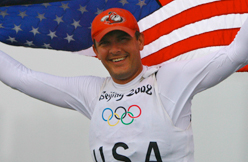For Zach Railey, working out in the gym has little to do with looking good on the beach. Sailors like Railey, a silver medalist at the Beijing 2008 Olympic Games, don't need a lot of strength in their chest and pectoral muscles.
Instead, sailors mostly focus on exercises to improve their hips, quadriceps, lower back and shoulders, said Chris Herrera, strength and conditioning coach for U.S. Sailing. Olympic-style lifts like cleans and snatches strengthen those areas, Herrera said.
Sailing is unique, Herrera said, because it involves anaerobic exercise, which builds up strength needed in short bursts such as in football plays, and it also involves aerobic exercise, which can build up cardiovascular benefits for longer distance events such as cross country skiing.
Herrera and Railey met in 2005 at the University of Miami when Herrera was working on his doctorate in physical therapy and Railey was an undergraduate student. Since then, they have created exercise routines designed specifically for sailing. For example, sitting on an exercise ball while doing repetitive lifts might mimic the instability of sitting in a boat on the water.
While Railey will undoubtedly anchor his quest for gold at the London 2012 Olympic Games with work on the water, about half of his work is on land as well. A 25-year-old from Clearwater, Fla., Railey estimates 30 percent of his Olympic preparation involves time in the gym and mental preparation, and 20 percent involves other activities such as fundraising.
"Obviously, performance on the water is number one," Railey said. "Practice time on the water is one big aspect. The second big one is off the water with physical training in the gym and mental training. The third one is financial."
Herrera now runs Bow Down Training, an exercise business designed specifically to prepare sailors for competition. He works closely with the U.S. sailing team. Railey acts as a consultant for the business.
"Our goal is to be the fittest sailing team in the world," Railey said.
Standing 6-4 and weighing more than 200 pounds, Railey can count on physical strength as an asset. He needs it for sailing in the Finn class.
"It's kind of like an animal," Railey said of the Finn. "It's probably the hardest boat to sail in Olympic-class sailing."
Railey started sailing before he knew it was an Olympic sport. He took up sailing at 8 and was hooked after one lesson.
"I got in the car, and I told my mom that I absolutely loved it," he said.
Kenneth Andreasen, now the head coach of the U.S. Olympic sailing program, first saw Railey sail at 9.
"He was very determined and committed for sure," Andreasen said. "You could tell he was going to go somewhere."
Andreasen served as Railey's coach for about four years, including when Railey, at 11, became the youngest sailor to qualify and compete at the Optimist World Championships. Railey invaded the U.S. sailing team rankings in 2001 and has never left.
Railey in 2006 asked Andreasen to coach him again in preparation for the Olympic Games. His first-place showing at the U.S. Olympic Trials was followed by his silver medal in Beijing. Great Britain's Ben Ainslie became a three-time gold medalist and kept Railey off the top spot of the medal stand.
In 2012, Railey again could face Ainslie, and this time, they would meet in Ainslie's home country. Railey sailed at the 2012 Olympic Games site in Weymouth, England, this year when he won a bronze medal September 19 at Sail for Gold.
While the light air was a factor at the Olympic Games last year in Beijing, Railey said the ever-changing winds at Weymouth will definitely present challenges. The light air in China allowed Railey to drop down to 190 pounds, which he did over the course of about a year. He's now slowly getting back closer to 220 pounds through proper diet and time spent in the weight room.
Railey hopes to be in London along with his sister, 22-year-old Paige. An alternate on the 2008 U.S. Olympic team, Paige Railey won a gold medal in a Laser Radial fleet at the Princess Sofia Trophy in Palma de Mallorca, Spain, this past April. In July, she won the European Laser Radial Women's Championship in Charlottenlund, Denmark.
Zach Railey is aware all Olympic dreams need funding. He estimates he needs $120,000 to $150,000 a year to train. He receives support from the U.S. Olympic Committee. The U.S. team goes by the name U.S. Sailing Team AlphaGraphics because of that company's support.
Railey said he still has to raise another $40,000 to $60,000 in funding each year on his own. He said his degree in business administration from the University of Miami comes in handy. He has found such sponsors as Sunsail and Sperry Top-sider. Auctions are another source of income. His Web site explains how personal donations can qualify people for a drawing that will give away a sailboat from Sunsail.
Railey also uses social media tools on his Web site, and he Twitters. His Web site, www.zach2012.com, leaves no doubt about his goal.
That goal will require a commitment on land.
"He's enthusiastic about training," Herrera said. "He's always wanting to learn more, and because he wants to learn more, he retains more. He's a dream athlete to work with."
But, of course, that goal will ultimately come down to his performance on the water.
"He can perform when he has to under pressure," Andreasen said. "He's very strong, and he can keep his cool."

(teamusa.org)


